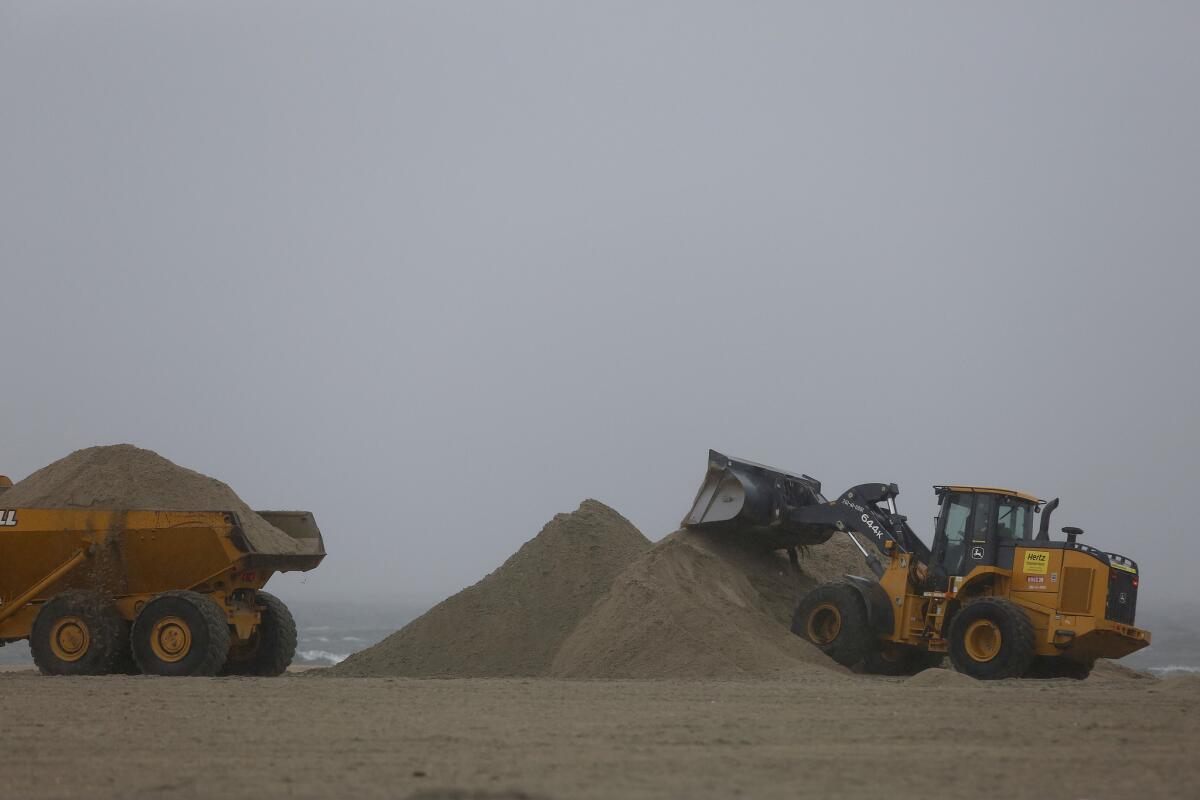El Niño flooding made worse by garbage, debris dumping

Earthmoving equipment move beach sand to protect vulnerable areas from flooding in rainy weather during the first big storm in what is predicted to be a strong El Niño event in Southern California.
- Share via
El Niño hit Southern California on Tuesday morning and is already causing minor flooding on some roads and sidewalks.
Flooding prompted officials to close roads in the Sepulveda Dam area, and motorists reported some roadway flooding on the 101 Freeway between Ventura and Santa Barbara.
The storm is expected to dump 2 to 3 inches of rain through Friday across the L.A. basin. While that’s not historic, it’s enough to cause flooding.
See the most-read stories this hour >>
What causes road and sidewalk flooding?
Heavy rain, of course, is a major factor. But trash is another. Garbage and debris clog storm drains.
And litter is a big problem in L.A.
A report prepared in 2014 concluded that city streets, sidewalks and alleys were so strewn with garbage that the situation threatened L.A.’s international image. In August, an investigation by The Times found that from January 2010 to June 2015, city crews did not respond to more than a third of requests made for removal of illegally dumped items in parts of central, Northeast and South L.A.
How about trash cans?
When residents put their trash bins on the curb, the containers sometimes block storm drains, leaving water to form puddles in low-lying areas or flow down the street. A relatively small amount of fast-moving water can also knock a trash bin over and carry the bin -- or its contents -- to another location, where it can clog the system and hasten flooding.
L.A. officials have talked about suspending trash pickup during heavy storms. Doing this might ensure that there would be less debris on the streets that could cause problems.
What are some driving tips?
Here are some tips from the California Highway Patrol:
How about beaches?
Yes, much of the garbage ends up in the ocean, causing pollution. Here are some tips from L.A. County on this:
Don’t put anything in storm drains but rainwater. Storm drains and flood control channels carry surface runoff directly to the rivers and ocean without treatment. Make sure that runoff carries only rainwater.
Avoid throwing litter into the street. Trash-laden gutters increase neighborhood pollution and clog storm drains, causing street flooding and more traffic congestion.
Pick up after your pet. Animal waste, when left on the ground, washes down storm drains and contaminates beaches. Picking up dog waste is a County ordinance and dog owners disregarding this law may be fined.
Recycle your motor oil. There are more than 650 gas stations, auto parts stores and repair shops that will collect and recycle used motor oil.
Bag, compost or recycle grass, tree limbs, leaves and other yard waste. Soggy yard waste is a major contributor to clogged storm drains and street and neighborhood flooding.
Use yard waste as mulch, as natural fertilizer, or as ground cover. Nearly 20% of landfill waste, such as grass and tree trimmings, is from our yards.
Encourage local businesses to start a recycling program if they don’t already have one. Consumers should take their business to companies that have an environmental conscience.
Use double-sided photocopies. You can cut down on paper costs and reduce waste by making double-sided originals and copies whenever possible.
- Don’t use harsh, abrasive or toxic chemicals around the house. Select water-based products over solvent-based products when available (e.g.. paint, glue, shoe polish). Also, avoid aerosol sprays; choose a pump spray or other alternatives.
ALSO
FULL COVERAGE: Preparing for El Niño >>
Are you ready for El Niño? Here’s how to stay safe
How to drive in the rain: A guide for Southern Californians
A steady conveyor belt of El Niño storms is what has officials concerned
More to Read
Sign up for Essential California
The most important California stories and recommendations in your inbox every morning.
You may occasionally receive promotional content from the Los Angeles Times.













